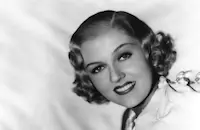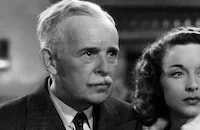Side Streets

Brief Synopsis
Cast & Crew
Alfred E. Green
Aline Macmahon
Paul Kelly
Ann Dvorak
Dorothy Tree
Helen Lowell
Film Details
Technical Specs

Synopsis
Bertha Krasnoff, an unmarried woman in her thirties, meets unemployed sailor Tim O'Hara and offers him a meal and a room for the night. Learning that he is having difficulty finding a job, she hires him, against the better judgment of her employee, Tilly, to help out in Madame Valerie's, the San Francisco fur shop that she owns. Soon they are married. Despite Bertha's kindness, Tim has a roving eye. While Bertha feels sad about selling a fur coat to Madeline Ware, the mistress of businessman George Richards, because his wife is a wonderful woman, her own husband becomes involved with Marguerite Gilbert. When Tim learns that Bertha is pregnant, however, he ends his relationship with Marguerite and swears to be faithful. After the baby is born, Bertha sends for her niece Ilka to help out in the store. Ilka is attracted to Tim, but he remains faithful to his wife until the baby dies. One day, Marguerite comes to the store looking for Tim. Not realizing that Bertha is his wife, she tells her that she has given birth to Tim's baby. Bertha tells her that Tim has left town, but gives Marguerite money for the baby. She continues to visit Marguerite and the baby while Tim becomes involved with Ilka. After Bertha learns that Madeline has committed suicide, she uses a ruse to reconcile the Richards. Meanwhile, Tim has decided to run away with Ilka. Bertha discovers them, but when Ilka accuses her of being an old and ugly woman who cannot hold on to her young husband, Bertha sends them away. While they are packing, Marguerite tells Bertha that she has a chance to marry an Australian man and wonders if Bertha will take the baby. Bertha gladly agrees. Tim overhears their conversation, and once again his mind is changed by a baby. He sends Ilka away without him and returns to Bertha.

Director
Alfred E. Green
Cast

Aline Macmahon

Paul Kelly

Ann Dvorak

Dorothy Tree
Helen Lowell

Henry O'neill

Mayo Methot
Renee Whitney
Lynn Browning
Lorena Layson

Dorothy Peterson

Clay Clement
Paul Kaye

Marjorie Gateson

Patricia Ellis

Joseph Crehan
Edward Gargan
Huey White
Larry Mcgrath
Helen Phillips
Sarah Edwards
Hallene Hill

Howard C. Hickman
John Elliott
Crew

Film Details
Technical Specs

Articles
Side Streets (1934) - Side Streets
As mediocre pictures go, this romantic drama is not without a measure of interest. Unfortunately, Dvorak's role was relatively minor. In her previous title role in Housewife (1934), in which she was third billed, Dvorak had been the loyal spouse who has to compete with a sophisticated Bette Davis for the affections of husband George Brent. Here, she is consigned to the Other Woman role. The lead goes to Aline MacMahon, a Broadway star of the 1920s who had only been in movies a year. MacMahon plays Bertha Krasnoff, owner of a San Francisco fur shop who takes in a penniless, homeless sailor (Paul Kelly), first as her employee, then as her husband. It soon becomes clear, however, especially after Miss Dvorak shows up, that Bertha's hubby is a womanizer who only married her for her money. After a string of extra-marital affairs and childbirth traumas, the husband realizes Bertha is the woman for him after all.
It's a telling fact about Hollywood's attitudes toward women and marriage at the time that one of the working titles of the film was A Woman in Her Thirties, implying there is something out of the ordinary about a woman of that age (MacMahon was about 35 when she made this) who is not yet married, especially if she is not conventionally attractive. The notion is reinforced when Bertha's scheming niece Ilka, who has fallen for Bertha's husband, lays into her for being an ugly old woman who can't hold onto her younger man. In fact, MacMahon in the 1920s was lauded for her beauty, and her heavy-lidded, melancholy looks were inspirations for sculptors and photographers.
The other working title for the film was Fur Coats, the name of the short story by Ann Garrick and Ethel Hill on which the movie is based. Bertha's fur business gives rise to interesting subplots, as she bilks rich men and their mistresses for expensive coats, her way of condemning the marital infidelity that is ironically providing her with a tidy living and the means to keep a ne'er-do-well husband.
Even after breaking into movies, MacMahon continued her stage career well into her later life. Her leading lady period in films was short-lived, but she made strong impressions in supporting parts through the mid-1960s in such films as Gold Diggers of 1933 (1933), Babbitt (1934), Dragon Seed (1944, an Oscar® nomination for Best Supporting Actress), and Diamond Head (1963). In her last feature role, she recreated her stage success as Aunt Hannah in All the Way Home (1963), based on James Agee's novel A Death in the Family. She continued to work on television, but retired in 1975 after the death of her husband, architect and planned-city pioneer Clarence S. Stein. She died in 1991 at the age of 92.
Ann Dvorak worked with director Alfred E. Green four times in all, previously in the aforementioned Housewife, which was also written by Side Streets scripter Manuel Seff. Green's film career stretched from 1916 to 1954 and included several biographical pictures: Disraeli (1929), The Jolson Story (1946), The Fabulous Dorseys (1947), and The Jackie Robinson Story (1950). He also directed Barbara Stanwyck in one of her best pre-code potboilers, Baby Face (1933) and Bette Davis in her first Oscar®-winning role, Dangerous (1935). After leaving pictures, he worked for a few years on television, notably on the series The Millionaire from 1955 to 1958.
Cinematographer Byron Haskin became a director later in his career (Treasure Island, 1950; The War of the Worlds, 1953). At this time, however, he was also an important part of the Warner Brothers special effects team, which won a Technical Achievement Award in 1939 for pioneering the development and first practical motion picture application of the triple head background projector. Haskin and sound engineer Nathan Levinson were co-nominated four times for special effects. Among Haskin's notable effects credits are A Midsummer Night's Dream (1935), The Roaring Twenties (1939), The Sea Hawk (1940), High Sierra (1941), and Arsenic and Old Lace (1944).
Side Streets earned mixed reviews and did nothing to help Dvorak's fading career at Warner Brothers. Mordaunt Hall, in an August 1934 review in the New York Times, gave MacMahon and Kelly credit for doing their best with thankless roles but only mentioned Dvorak off-handedly, erroneously crediting her with playing the part of Ilka.
Director: Alfred E. Green
Producer: Samuel Bischoff
Screenplay: Manuel Seff
Cinematography: Byron Haskin
Editing: Herbert Levy
Art Direction: Anton Grot
Original Music: Heinz Roemheld (uncredited)
Cast: Aline MacMahon (Bertha Krasnoff), Paul Kelly (Tim O'Hara), Ann Dvorak (Marguerite Gilbert), Dorothy Tree (Ilka), Helen Lowell (Tillie), Mayo Methot (Maizie Roach).
BW-64m.
by Rob Nixon

Side Streets (1934) - Side Streets
Quotes
Trivia
Notes
Ann Garrick's and Ethel Hill's story was entitled "Fur Coats." The working titles of this film were Fur Coats and A Woman in Her Thirties. Renee Whitney's character is variously called Mable and Betty Vernon. The character name does not appear onscreen.















